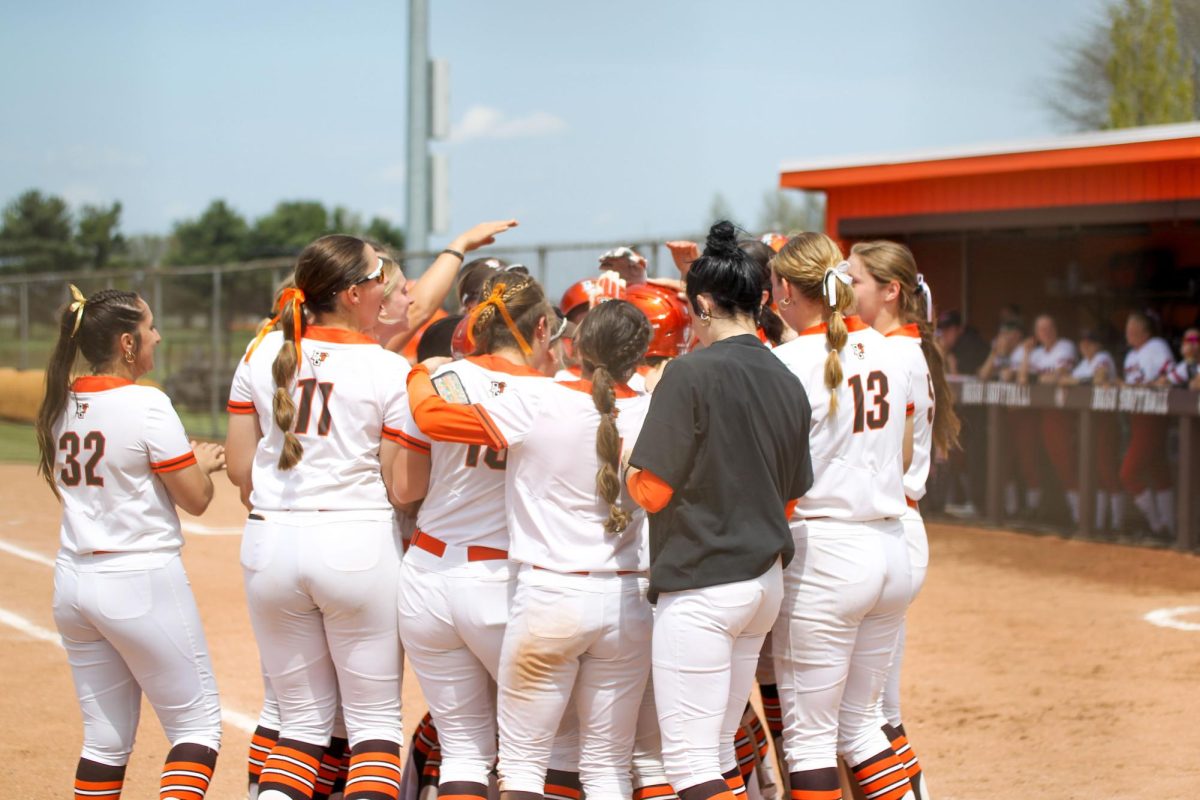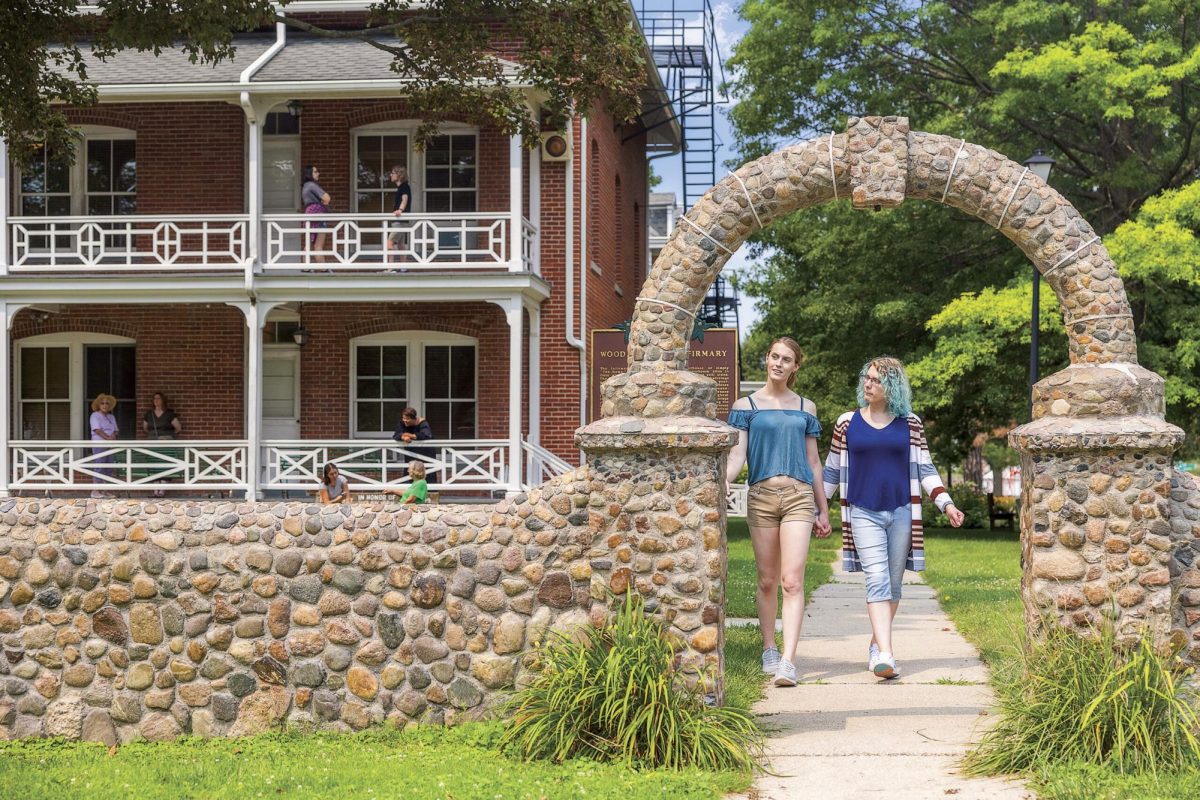Several environments are conducive for learning at the University such as a traditional classroom, an online course – and a laboratory 2,500 feet above the ground.
For students earning a degree in aviation studies, the latter would be the most influential (and most likely the most enjoyable) option to learn how to fly airplanes.
The University, along with Ohio State, Kent State, and Ohio University, is one of only four schools in Ohio to offer an aviation program. Students at the University can enter one of three specializations: aviation management and operations, aviation technical management or flight technology and operations, which is for students who want to become pilots (90 percent of students entering the aviation department opt for this specialization).
Students in the department, which is certified by the Federal Aviation Administration, get their training zipping up and down the four runways behind the University’s Technology Annex located on Poe Road. Approximately 50 airplanes take off and land on the runways each week, giving students first-hand pilot experience continuously.
Graduates from the department go into several flight-related careers such as becoming a corporate pilot, which is senior Shane Tyda’s dream.
Set to graduate in August, Tyda fell in love with airplanes when he first stepped into one for a karate tournament 11 years ago. After visiting several air shows over the years and going for rides with the Flying Eagles in Bowling Green, Tyda still carries the same passion for flying today as when he was a child.
With 350 hours of flight experience underneath his pilot belt, flying never gets stale to Tyda. He said every time he lifts off from the ground, the thrill of flying is the same whether it was his first time or his last.
‘Flying is always fun,’ Tyda said. ‘I told my dad I could never see flying getting old. When it doesn’t feel like work, you know you went in the right direction.’
And while Tyda looks down on structures like Doyt L. Perry Stadium and the city water tower, which resemble toys more than city landmarks, he is reminded of the uniqueness of learning how to fly.
‘It’s unlike any other major you can possibly do,’ Tyda said. ‘You get to explore the world from another point of view.’
Passing with flying colors Students in the aviation department learn much differently than other students in more traditional style majors. Within their first 10 hours of classes, students are put into planes where they immediately learn if flying is for them, making the aviation major a very hands-on learning experience.
‘It’s a different type of educational process than some majors at the University,’ Director of Aviation Studies Jon McDermott said. ‘Not only do you have to have the knowledge of what is going on and the subject matter, but you have to apply that subject matter to a three-dimensional moving object.’
Inevitably, students in the department face some turbulence along the way to earning a degree. Anywhere from 10 to 15 percent of incoming freshmen will quit the program due to the workload, McDermott said.
After the first year, students have to endure several midterms and final exams in the form of written tests, oral exams and flight checks.
‘You’re constantly being tested knowledge wise,’ senior aviation major Brad Willford said.
Willford goes through days when the work is overbearing, but his ultimate dream of becoming an F-16 pilot for the Toledo Air National Guard motivates him through those tough times.
‘You definitely have to be dedicated,’ Willford said. ‘It’s definitely not sit back, listen and you’ll get everything. You have to put some effort into studying and reading up on information that doesn’t make sense to you.’
While it would be easier for the department to administer the minimum requirements issued from the FAA, McDermott said he wants students coming from the University to be better than just marginal pilots.
Even though students can still earn average grades and have the physical skills to fly, McDermott said he would rather see his pupils excel in both fields, ensuring their future success in becoming pilots.
And when students prove they are ready to accept the responsibilities of studying and flying, they still might not be able to.
Students cannot enter the program if they have had any past drug involvement, take certain prescription medications, have particular diseases (like attention deficit hyperactivity disorder) or have any involvement with alcohol on their public records.
‘I have to remind them they have to do good in the classroom and across campus,’ McDermott said. ‘You can’t just be a pilot. You have to be a BGSU graduate.’
The student becomes the teacher One technique the aviation department uses to further students’ knowledge of aviation is having upperclassmen teach freshmen how to fly.
Offered as an elective, students can take a course to become a certified flight instructor to help other students fly while honing their own personal skills.
‘[Students] are not just flying the plane anymore,’ said Assistant Chief Flight Instructor Catherine Smith, who instructs the class. ‘They are articulating on why things are done in a certain way. They are becoming a teacher in the airplane.’
Smith said the students who do become instructors end up with a better understanding of how a plane operates by teaching the material.
Junior Angela Kovaleski realized the importance of taking the instructor course and how it would improve her piloting skills.
‘As an instructor, you are constantly going over that knowledge and keeping it fresh in your mind, making you a safer and better pilot,’ Kovaleski said.
And the course has extra benefits associated with flying other than just personal knowledge.
Flight instructor experience will put students in a better position after graduation. If students who are certified are competing with others for an aviation-related job, chances are they will receive the position if the others do not have the same instructor training, Smith said.
‘It’s an extra level of certification and it does put our graduates in a better position for the industry,’ Smith said.
Even though teaching was not on her academic scheduled route, Kovaleski said it was a worthwhile detour to become an instructor and teach others how to fly.
‘I wasn’t in the major to teach, but I think this is something that will help me grow,’ she said. ‘I’m definitely excited to see how good I can make my students.’
Prepare for a successful landing With campus-wide cuts across the University, the department is not worrying about aspects it cannot control.
But one factor they can make sure remains constant is safety, Chief Flight Instructor Joan Kitchen said.
Never encountering one death or major airplane-related injury in Kitchen’s 17-year tenure, the department is constantly proving its worth to the University by showing how safe students are in compromising positions, such as flying thousands of feet in the air.
‘We have worked very hard over the years to keep the program here,’ Kitchen said. ‘We make sure everyone stays safe and does what they are supposed to do. The better training of the students will ensure the longevity of the program.’
Flying next to nervous, inexperienced students, Kitchen is witness to their weaknesses and vulnerabilities, but over time, students master the art of flying, she said.
Throughout the process, Kitchen said she sees the student grow not only as a better pilot, but also as a more mature and overall improved person.
‘These students are second only to my children,’ Kitchen said. ‘It always makes me happy when they graduate. I’m sorry they are leaving because I’ll miss them, but at the same time, I’m very happy for them to succeed.’
And with the care instructors like Kitchen give to students during their time at the University, they return the favor by becoming certified pilots.
‘I never thought I could actually fly an airplane until I came here,’ Kovaleski said. ‘I never had confidence before I started taking classes at Bowling Green. Now [I have] confidence.’
Compared to the other three aviation schools in Ohio, Willford said the University is an ideal place for any student to enroll in aviation studies.
‘For my time and training, I wouldn’t say there would be any better place,’ he said. ‘I would definitely recommend [the University] to other students.’
‘
‘ THE FIVE TRAITS
When students first start flying, amateur pilots sometimes display traits from one of the five ‘hazardous attitudes’ which include: Macho (‘I can do anything’): The student is always trying to prove they are the best by taking unwarranted risks beyond their training Invulnerability (‘It will never happen to me’): The student thinks nothing wrong will ever occur flying in a plane, not even an accident. Impulsivity (‘I want to do this now!’): The student feels action needs to be taken, even when all seems right. ‘ Anti-authority (I don’t have to listen to you’): The student ignores rules, regulations and advice from the instructor. Resignation (‘I quit’): The student gives up all hopes and feels helpless while flying
Source: FAA Pilot Handbook of Aeronautical Knowledge ‘ COST OF FLYING The aviation studies major is the most expensive program a student can earn a degree in at the University. Students have to pay approximately $150 per hour they are partaking in flight-related courses. Along with tuition, students are required to pay additional fees for courses to offset instructor, laboratory and gasoline fees and prices. Required Courses for Flight Technologies and Operations (Students Preparing to Become a Pilot): Private Pilot Flight Instruction I: $4,437 Private Pilot Flight Instruction II: $4,804 Instrument I: $8,311 Instrument II: $8189 Commercial/Multi I: $5,567 Commercial/Multi II: $10,448 Glass Cockpit Training: $1,908 Total Cost for Seven Required Courses: $43, 664 Elective Courses: Flight Instructor-Airplane: $4,280 Flight Instructor-Instrument: $2,086 Multi-Engine Flight Instructor:$2,892 Total Cost for Three Elective Courses: $9,258 Note: Many students do not have to pay full price for courses as numerous scholarships and grants are available. Students can also use financial aid to help pay for these courses. Source: Aviation Studies Flight Instruction Rates 2009-10.
‘

















